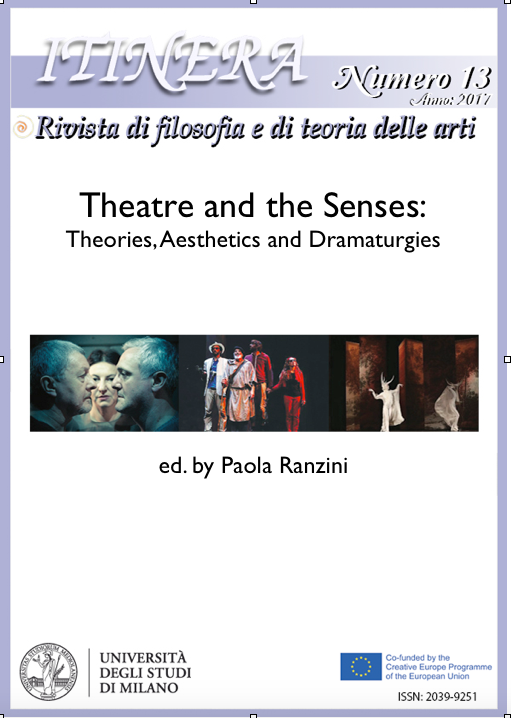« Perhaps That Taste of Nothing Is What You Can Taste » : Sensory Landscapes, Absence, and Objects in Martin Crimp’s « The Country »
DOI:
https://doi.org/10.13130/2039-9251/8734Abstract
When Martin Crimp’s The Country was first performed at London’s Royal Court Theatre in 2000, critics focused on its Pinterian echoes, the popular motif of betrayal, as well as its attack on the rural myth, and described it as a disturbing and ambiguous play. Despite its unsettling elusiveness and coolness, The Country is a hot piece, in which sensual and sexual tensions permeate chilling verbal exchanges between cryptic – and seemingly unemotional – characters. Staging an intricate web of sensory reactions, provoked by the (im)materiality of language and the evocative potential of props, this drama effectively «works through affective nuances […], acoustic and visual, which develop an almost haunting presence in their absence» (Angelaki 2012: 97). Examining Crimp’s sensory landscapes and his subtle dialogue between presence and absence, this article aims to demonstrate how, in an opaque play built on ellipses, the body sous rature speaks as loud as the ostended body.
Riferimenti bibliografici
ANGELAKI, Vicky, The Plays of Martin Crimp: Making Theatre Strange, Palgrave Macmillan, Basingstoke-New York 2012.
BILLINGTON, Michael, Review of The Country, Guardian, 17 May 2000; Theatre Record, vol. XX, no. 10 (2000), p. 618.
BROWN, Georgina, Review of The Country, Mail on Sunday, 21 May 2000; Theatre Record, vol. XX, no. 10 (2000), p. 616.
BUSE, Peter, “Sollicitations téléphoniques: La Campagne de Martin Crimp”, in É. Angel-Perez and N. Boireau (ed. by), Le théâtre anglais contemporain (1985-2005), Klincksieck, Paris 2007, pp. 153-168.
CAPITANI, Maria Elena, “‘The Treatment Was Wild’: medicina, desiderio e coscienza in The Country di Martin Crimp”, La Torre di Babele. Rivista di Letteratura e Linguistica, VIII, 2012, pp. 213-235.
__________________, “Dealing with Bodies: The Corporeal Dimension in Sarah Kane’s Cleansed and Martin Crimp’s The Country”, Journal of Contemporary Drama in English, I/I, 2013, pp. 137-148.
CRIMP, Martin, The Country, in M. Crimp, Plays Two: No One Sees the Video, The Misanthrope, Attempts on Her Life, The Country, introduced by the author, Faber and Faber, London 2005, pp. 285-366.
DI BENEDETTO, Stephen, The Provocation of the Senses in Contemporary Theatre, Routledge, New York-Abingdon 2010.
ESCODA AGUSTÍ, Clara, Martin Crimp’s Theatre: Collapse as Resistance to Late Capitalist Society, de Gruyter, Berlin-Boston 2013.
GARNER, Stanton B., Jr., Bodied Spaces: Phenomenology and Performance in Contemporary Drama, Cornell University Press, Ithaca 1994.
HEMMING, Sarah, Review of The Country, Financial Times, 24 May 2000; Theatre Record, vol. XX, no. 10 (2000), pp. 620-621.
MARLOWE, Sam, Review of The Country, What’s On, 24 May 2000; Theatre Record, vol. XX, no. 10 (2000), p. 616.
MCEVOY, William, Review of The Country, Sunday Telegraph, 21 May 2000; Theatre Record, vol. XX, no. 10 (2000), pp. 617-618.
NATHAN, David, Review of The Country, Jewish Chronicle, 19 May 2000; Theatre Record, vol. XX, no. 10 (2000), p. 617.
SIERZ, Aleks, The Theatre of Martin Crimp (2006), Bloomsbury Methuen Drama, London-New York 2013 (2nd edition).
SPENCER, Charles, Review of The Country, Daily Telegraph, 18 May 2000; Theatre Record, vol. XX, no. 10 (2000), pp. 616-617.
TAYLOR, Paul, Review of The Country, Independent, 18 May 2000; Theatre Record, vol. XX, no. 10 (2000), p. 620.
WHITLEY, John, “The Enigma that is Mr Crimp” [online], The Telegraph, 11 May 2000. Available at: http://www.telegraph.co.uk/culture/4720678/The-enigma-that-is-Mr-Crimp.html. Last accessed 22 May 2016.
Dowloads
Fascicolo
Sezione
Licenza
Gli autori che pubblicano su questa rivista accettano le seguenti condizioni:
1. Gli autori mantengono i diritti sulla loro opera e cedono alla rivista il diritto di prima pubblicazione dell'opera, contemporaneamente licenziata sotto una Licenza Creative Commons - Attribuzione - Condividi allo stesso modo 4.0 internazionale che permette ad altri di condividere l'opera indicando la paternità intellettuale e la prima pubblicazione su questa rivista.
2. Gli autori possono aderire ad altri accordi di licenza non esclusiva per la distribuzione della versione dell'opera pubblicata (es. depositarla in un archivio istituzionale o pubblicarla in una monografia), a patto di indicare che la prima pubblicazione è avvenuta su questa rivista.
3. Gli autori possono diffondere la loro opera online (es. in repository istituzionali o nel loro sito web) prima e durante il processo di submission, poiché può portare a scambi produttivi e aumentare le citazioni dell'opera pubblicata (Vedi The Effect of Open Access).





